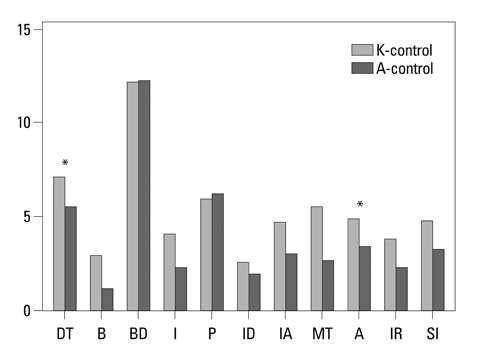Yonsei Med J.
2012 Nov;53(6):1099-1106. 10.3349/ymj.2012.53.6.1099.
Validation of the Korean Version of the Eating Disorder Inventory-2: Psychometric Properties and Cross-Cultural Comparison
- Affiliations
-
- 1Institute of Behavioral Science in Medicine, Yonsei University College of Medicine, Gwangju, Korea. drgreat@yuhs.ac
- 2Mind & Mind Eating Disorder Clinic, Seoul, Korea.
- 3Severance Mental Health Hospital, Gwangju, Korea.
- 4Department of Psychiatry, Yonsei University College of Medicine, Seoul, Korea.
- KMID: 1414250
- DOI: http://doi.org/10.3349/ymj.2012.53.6.1099
Abstract
- PURPOSE
The purpose of the present study was to examine the validity and reliability of the Korean version of the Eating Disorder Inventory-2 (EDI-2) in Korean patients with eating disorders and healthy controls, and to investigate cultural differences of EDI-2 between a Korean group and a North American standardization sample.
MATERIALS AND METHODS
The Korean version of the EDI-2 was prepared after comprehensive clinical assessment of Korean patients with eating disorders (n=327) as well as female undergraduates (n=176). Results were compared between eating disorder subgroups (anorexia nervosa, bulimia nervosa and eating disorders not otherwise specified) and those of a North American standardization sample and healthy controls.
RESULTS
The results showed that the Korean EDI-2 had adequate internal consistency (0.77-0.93) and discriminated well between patients with eating disorders and healthy controls on all subscales. Significant differences in EDI-2 subscale scores between the eating disorder groups and the healthy control group were observed; however, there was no discernible difference among the eating disorder subgroups. When compared with a North American standardization sample, the Korean control group showed significantly higher scores for drive for thinness and asceticism. When patient groups were compared, the Korean group showed significantly lower scores for perfectionism.
CONCLUSION
As expected, the results accurately reflected psychometric properties of the Korean version of EDI-2 for eating disorder patients in Korea. These findings also suggest that common characteristics for the eating disorder exist as a whole rather than with significant difference between each subgroup. In addition, significant differences between the Korean and the North American groups for both patients and controls also demonstrated specific cultural differences.
MeSH Terms
Figure
Reference
-
1. Pate JE, Pumariega AJ, Hester C, Garner DM. Cross-cultural patterns in eating disorders: a review. J Am Acad Child Adolesc Psychiatry. 1992. 31:802–809.
Article2. Crago M, Shisslak CM, Estes LS. Eating disturbances among American minority groups: a review. Int J Eat Disord. 1996. 19:239–248.
Article3. Pike KM, Walsh BT. Ethnicity and eating disorders: implications for incidence and treatment. Psychopharmacol Bull. 1996. 32:265–274.4. Striegel-Moore RH, Silberstein LR, Rodin J. Toward an understanding of risk factors for bulimia. Am Psychol. 1986. 41:246–263.
Article5. Norring C, Sohlberg S. Eating Disorder Inventory in Sweden: description, cross-cultural comparison, and clinical utility. Acta Psychiatr Scand. 1988. 78:567–575.
Article6. Garner DM. Eating disorder inventory-2: Professional manual. 1991. FL: psychological assessment resources.7. Lee S, Lee AM, Leung T, Yu H. Psychometric properties of the Eating Disorders Inventory (EDI-1) in a nonclinical Chinese population in Hong Kong. Int J Eat Disord. 1997. 21:187–194.
Article8. Pike KM, Mizushima H. The clinical presentation of Japanese women with anorexia nervosa and bulimia nervosa: a study of the Eating Disorders Inventory-2. Int J Eat Disord. 2005. 37:26–31.
Article9. Bae JH, Choi JY. A study on psychological characteristics of eating disorders: a comparision with restrained, unrestrained (normal) eaters, and overweighters. Korean J Clin Psychol. 1997. 16:209–217.10. Kaiser HF. The varimax criterion for analytic rotation in factor analysis. Psychometrika. 1958. 23:187–200.
Article11. Eklund K, Paavonen EJ, Almqvist F. Factor structure of the Eating Disorder Inventory-C. Int J Eat Disord. 2005. 37:330–341.
Article12. Mayer JD, DiPaolo M, Salovey P. Perceiving affective content in ambiguous visual stimuli: a component of emotional intelligence. J Pers Assess. 1990. 54:772–781.
Article13. Fairburn CG, Cooper Z, Shafran R. Cognitive behaviour therapy for eating disorders: a "transdiagnostic" theory and treatment. Behav Res Ther. 2003. 41:509–528.
Article14. Root MPP. Disordered eating in women of color. Sex Roles. 1990. 22:525–536.
Article15. Markus HR, Kitayama S. The cultural construction of self and emotion: Implication for social behaviour. 1997. Washington: American Psychological Association.16. Triandis HC. Individualism & collectivism. 1995. Boulder: Westview Press.17. Lee S, Lee AM, Leung T. Cross-cultural validity of the Eating Disorder Inventory: a study of Chinese patients with eating disorders in Hong Kong. Int J Eat Disord. 1998. 23:177–188.
Article18. Yamaguchi N, Kobayashi J, Tachikawa H, Sato S, Hori M, Suzuki T, et al. Parental representation in eating disorder patients with suicide. J Psychosom Res. 2000. 49:131–136.
Article19. Waldherr K, Favaro A, Santonastaso P, van Strien T, Rathner G. Comparison of the eating disorder inventory (EDI) in the Netherlands, Austria and Italy. Eur Eat Disord Rev. 2008. 16:472–479.
Article20. Tachikawa H, Yamaguchi N, Hatanaka K, Kobayashi J, Sato S, Mizukami K, et al. The Eating Disorder Inventory-2 in Japanese clinical and non-clinical samples: psychometric properties and cross-cultural implications. Eat Weight Disord. 2004. 9:107–113.
Article21. Kim KH. The effects of adolescent girls' self-esteem, the preoccupation to be thinner, and dieting on binge eating. Korean J Clin Psychol. 1999. 4:155–165.22. Kordy H, Percevic R, Martinovich Z. Norms, normality, and clinical significant change: implications for the evaluation of treatment outcomes for eating disorders. Int J Eat Disord. 2001. 30:176–186.
Article
- Full Text Links
- Actions
-
Cited
- CITED
-
- Close
- Share
- Similar articles
-
- Psychometric properties of an instrument 2: structural validity, internal consistency, and cross-cultural validity/measurement invariance
- The Reliability and Validity of the Korean version of the Body Shape Questionnaire
- Measures of Eating Behaviors
- Cross-Cultural Aspect of Behavior Assessment System for Children-2, Parent Rating Scale-Child: Standardization in Korean Children
- Cross-cultural adaptation and validation of the Turkish Yellow Flag Questionnaire in patients with chronic musculoskeletal pain


